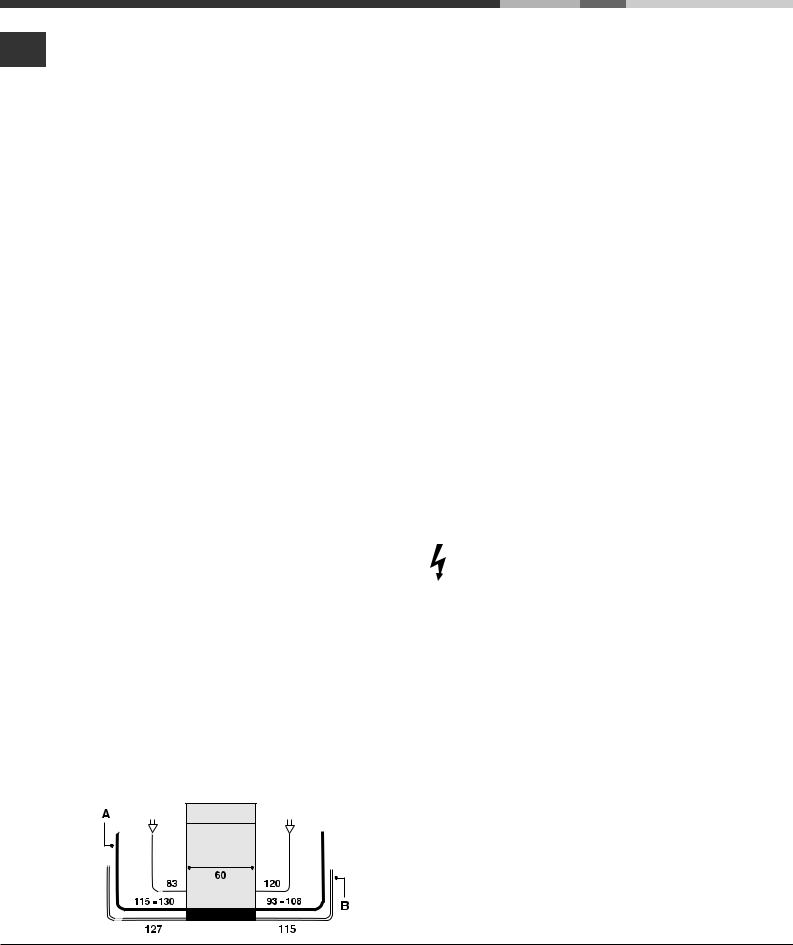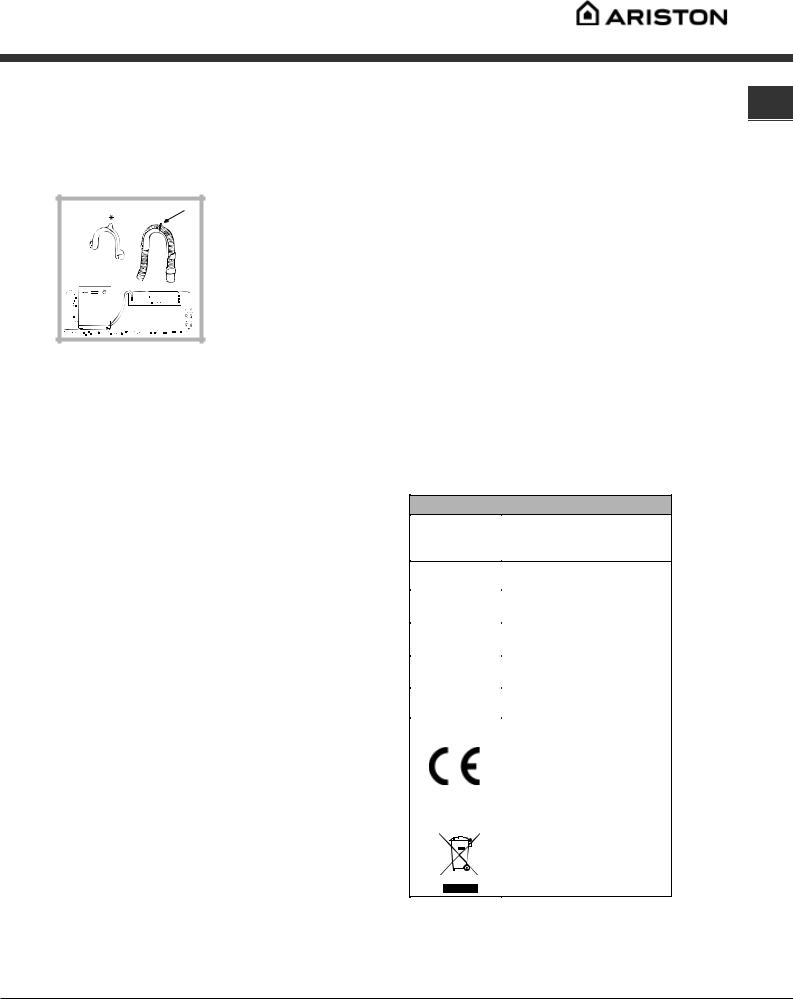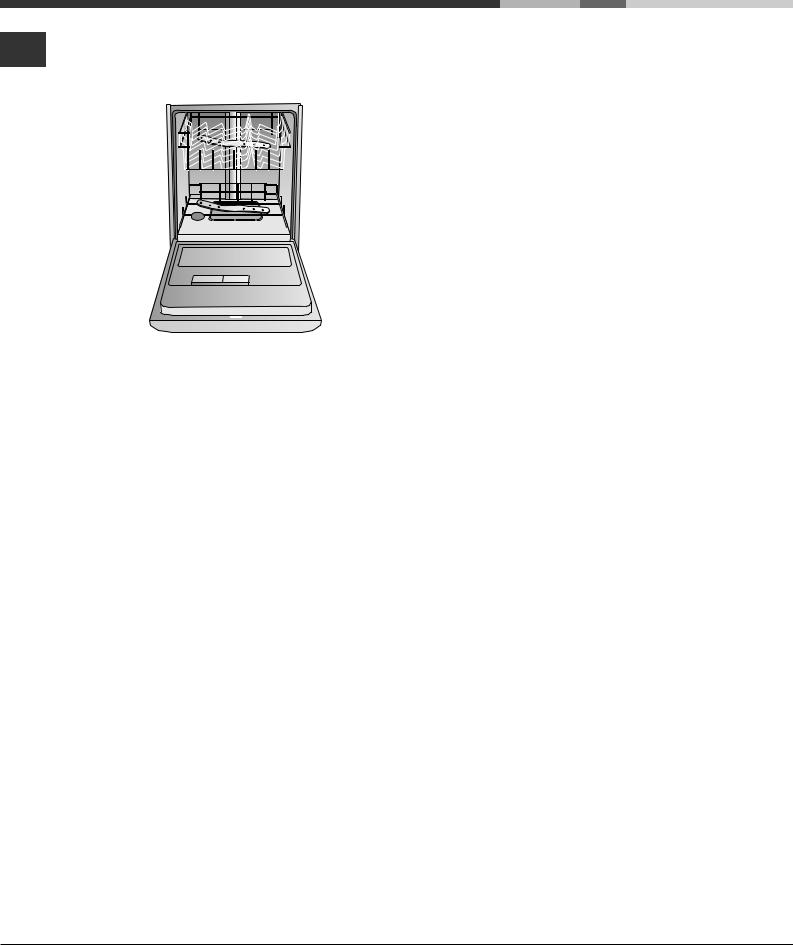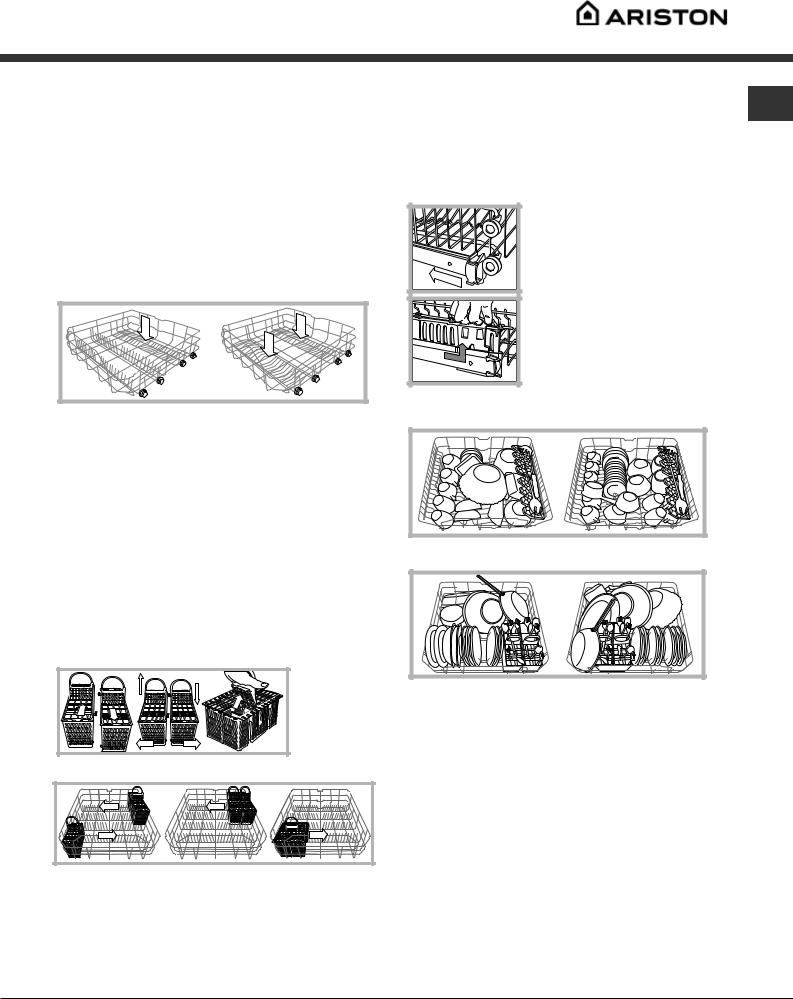Ariston LBF51X Operating Instructions

Operating instructions
DISHWASHER
|
EN |
|
Contents |
|
|
|
|
||
|
|
|
Installation, 2-3 |
|
English, 1 |
||||
Positioning and levelling |
||||
|
|
|
Connecting the water and electricity supplies |
|
|
|
|
Advice regarding the first wash cycle |
|
|
|
|
Technical data |
|
|
|
|
Description of the appliance, 4 |
|
|
|
|
Overall view |
|
|
|
|
Control panel |
|
|
|
|
Loading the racks, 5 |
|
|
|
|
Lower rack |
|
|
|
|
Cutlery basket |
|
|
|
|
Upper rack |
|
|
|
|
Start-up and use, 6-7 |
|
LBF 51
Starting the dishwasher Measuring out the detergent Wash options
LKF 720
Wash cycles, 8
Table of wash cycles
Rinse aid and refined salt, 9
Measuring out the rinse aid
Measuring out the refined salt
Care and maintenance, 10
Shutting off the water and electricity supplies
Cleaning the dishwasher
Preventing unpleasant odours
Cleaning the sprayer arms
Cleaning the water inlet filter
Cleaning the filters
Leaving the machine unused for extended periods
Precautions and advice, 11
General safety
Disposal
Saving energy and respecting the environment
Troubleshooting, 12
Assistance,12-13
Before contacting Assistance Ariston Priority Service
Genuine Accessories & Spare Parts

Installation
 Keep this instruction manual in a safe place for future EN reference. If the appliance is sold, given away or moved,
Keep this instruction manual in a safe place for future EN reference. If the appliance is sold, given away or moved,
please ensure the manual is kept with the machine, so that the new owner may benefit from the advice contained within it.
 Please read this instruction manual carefully: it contains important information regarding the safe installation, use and maintenance of the appliance.
Please read this instruction manual carefully: it contains important information regarding the safe installation, use and maintenance of the appliance.
 If the appliance must be moved at any time, keep it in an upright position; if absolutely necessary, it may be tilted onto its back.
If the appliance must be moved at any time, keep it in an upright position; if absolutely necessary, it may be tilted onto its back.
Positioning and levelling
1.Remove the appliance from all packaging and check that it has not been damaged during transportation.
If it has been damaged, contact the retailer and do not proceed any further with the installation process.
2.Check the dishwasher by placing it so that its sides or back panel are in contact with the adjacent cabinets or even with the
wall. This appliance can also be recessed under a single worktop* (see the Assembly instruction sheet).
3.Position the dishwasher on a level and sturdy floor. If the floor is uneven, the front feet of the appliance may be adjusted until it reaches a horizontal position. If the appliance is levelled correctly, it will be more stable and much less likely to move or cause vibrations and noise while it is operating.
4*. Adjust the height of the rear foot from the front of the appliance* on the central lower part of the dishwasher, turning a hexagonal spanner (red color) with an opening of 8 mm in a clockwise direction to increase the height or in an anticlockwise direction to decrease the height.
Connecting the water and electricity supplies
 Connection to the water and electricity supplies should only be performed by a qualified technician.
Connection to the water and electricity supplies should only be performed by a qualified technician.
 The dishwasher should not stand on top of the water hoses or the electricity supply cable.
The dishwasher should not stand on top of the water hoses or the electricity supply cable.
 The appliance must be connected to the water supply network using new hoses.
The appliance must be connected to the water supply network using new hoses.
Never use old or second hand hose sets. Do not reuse hose sets from any previously installed dishwasher.
The water inlet (A) and outlet (B) hoses and the electricity supply cable may be positioned towards the right or the left in order to achieve the best possible installation (see figure).
Connecting the water inlet hose
•To a suitable cold water connection point: before attaching the hose, run the water until it is perfectly clear so that any impurities that may be present in the water do not clog the appliance; after performing this operation, screw the inlet hose tightly onto a tap with a ¾ gas threaded connection.
•To a suitable hot water connection point: your dishwasher may be supplied with hot water from the mains supply (if you have a central heating system with radiators) provided that it does not exceed a temperature of 60°C.
Screw the hose to the tap as described for connection to a cold water supply.
 If the inlet hose is not long enough, contact a specialist store or an authorised technician (see Assistance).
If the inlet hose is not long enough, contact a specialist store or an authorised technician (see Assistance).
 The water pressure must be within the values indicated in the Technical data table (see adjacent information).
The water pressure must be within the values indicated in the Technical data table (see adjacent information).
 The hose should not be bent or compressed.
The hose should not be bent or compressed.
Anti-flooding protection
To ensure floods do not occur, the dishwasher:
- is provided with a special system which blocks the water supply in the event of anomalies or leaks from inside the appliance.
Some models are also equipped with the supplementary safety device New Acqua Stop*, which guarantees antiflooding protection even in the event of a supply hose rupture.
WARNING: HAZARDOUS VOLTAGE!
Under no circumstance should the water inlet hose be cut as it contains live electrical parts.
* Only available in selected models.
2

Connecting the water outlet hose
Connect the outlet hose (without bending it) to a drain duct with a minimum diameter of 4 cm. Alternatively, rest it over a sink or tub; the free end of the hose should not remain immersed in water.
A |
The special plastic elbow* makes it easier to find the best layout: fix the elbow to the wall securely in order to prevent the outlet hose from moving and spilling the dirty water.
The part of the hose marked with the letter A should be between 40 and 100 cm above the ground (see figure).
 We advise against the use of hose extensions.
We advise against the use of hose extensions.
Electrical connection
Before inserting the plug into the electrical socket, make sure that:
•The socket is earthed and complies with current regulations.
•The socket can withstand the maximum load of the appliance, which is indicated on the data plate located on the inside of the door (see chapter entitled Description of the appliance).
•The power supply voltage falls within the values indicated on the data plate on the inside of the door.
•The socket is compatible with the plug of the appliance. If this is not the case, ask an authorised technician to replace the plug (see Assistance); do not use extension cables or multiple sockets.
 Once the appliance has been installed, the power supply cable and the electrical socket should be easily accessible.
Once the appliance has been installed, the power supply cable and the electrical socket should be easily accessible.
 The cable should not be bent or compressed.
The cable should not be bent or compressed.
 If the power supply cable is damaged, it must be replaced by the manufacturer or its Technical Assistance Service in order to prevent all potential hazards. (See Assistance)
If the power supply cable is damaged, it must be replaced by the manufacturer or its Technical Assistance Service in order to prevent all potential hazards. (See Assistance)
 The Company shall not be held responsible for any incidents that occur if these regulations are not observed.
The Company shall not be held responsible for any incidents that occur if these regulations are not observed.
Anti-condensation strip*
After installing the dishwasher, open the door and stick the |
EN |
|
|
adhesive transparent strip under the wooden shelf in order to |
|
protect it from any condensation which may form. |
|
Advice regarding the first wash cycle
After the appliance has been installed, immediately before running the first wash cycle, completely fill the salt dispenser with water and add only then approximately 1 kg of salt (see chapter entitled Rinse aid and refined salt). The water may overflow: this is normal and is not a cause for concern. Select the water hardness value (see chapter entitled Rinse aid and refined salt). - After the salt has been poured into the machine, the LOW SALT indicator light* switches off.
 If the salt container is not filled, the water softener and the heating element may be damaged as a result.
If the salt container is not filled, the water softener and the heating element may be damaged as a result.
Technical data
width 60 cm
Dimensions height 85 cm depth 60 cm
Capacity |
14 standard place-settings |
|
|
|
|
Water supply |
0,05 ÷ 1MPa (0,5 ÷ 10 bar) |
|
pressure |
7,25 – 145 psi |
|
|
|
|
Power supply |
See appliance data plate |
|
voltage |
||
|
||
|
|
|
Total absorbed |
See appliance data plate |
|
power |
|
|
Fuse |
See appliance data plate |
|
|
|
|
|
This dishwasher conforms to |
|
|
the following European |
|
|
Community Directives: |
|
|
-2006/95/CE dated 16/01/2007 |
|
|
(Low Voltage) and subsequent |
|
|
modifications |
|
|
-89/336/EEC dated 03/05/89 |
|
|
(Electromagnetic Compatibility) |
|
|
and subsequent modifications |
|
|
-97/17/EC (Labelling) |
|
|
-2002/96/ CE Waste Electrical |
|
|
and Electronic Equipment |
|
|
(WEEE) |
* Only available in selected models.
3

Description of the appliance
Overall view
EN
1. Upper rack
2. Upper sprayer arm
3. Tip-up compartments
4. Rack height adjuster
5. Lower rack
6. Lower sprayer arm
7. Cutlery basket
8. Washing filter
9. Salt dispenser
10. Detergent and rinse aid dispensers
11. Data plate
12. Control Panel***
Control panel
|
Low Salt |
Half load |
Delayed start |
Washing and 3h. |
|
ON/OFF |
Delayed start |
||||
indicator light* |
button and |
button and |
indicator light* |
||
indicator light* |
|||||
indicator light* |
|||||
indicator light* |
|||||
|
|
||||
|
|
|
|
Drying and |
|
|
|
|
|
6h.Delayed start |
|
|
|
|
|
indicator light* |
|
|
End and 9h. |
|
|
Delayed start |
|
Multi-functional tablets |
indicator light* |
|
|
|
ON/OFF/RESET |
button and indicator light* |
Start/Pause button |
button |
|
and indicator light* |
|
Select wash |
|
Low Rinse aid |
|
|
cycle knob |
|
|
indicator light* |
|
|
|
|
***Only in completely built-in models. * Only available in selected models.
The number and type of wash cycles and options may vary depending on the dishwasher model.
4

Loading the racks
 Before loading the racks, remove all food residues from the crockery and empty liquids from glasses and cups.
Before loading the racks, remove all food residues from the crockery and empty liquids from glasses and cups.
After loading the appliance, check that the sprayer arms can rotate freely.
Lower rack
The lower rack can hold pans, lids, plates, salad bowls, cutlery, etc. as seen in the Loading examples.
Plates and large covers should be placed at the sides of the rack, ensuring that they do not block the rotation of the upper sprayer arm.
Some dishwasher models are fitted with tip-up sections*, which can be used in a vertical position when arranging plates or in a horizontal position when arranging pans and salad bowls.
Cutlery basket
The type of cutlery basket may vary according to the dishwasher model: it may be modular, non-modular or a sliding version. The non-modular basket must only be positioned at the front of the lower rack.
The modular basket may be separated into two parts, a solution which is recommended when performing a half load wash (only in models offering this option), is available in a sliding version (positioned at any point on the lower rack by sliding it between the fixed or tip-up inserts.
- Both versions are fitted with a collapsible sliding system which means the cutlery can be arranged in the best possible way.
 Knives and other utensils with sharp edges must be placed in the cutlery basket with the points facing downwards, or they must be positioned horizontally in the tipup compartments on the upper rack.
Knives and other utensils with sharp edges must be placed in the cutlery basket with the points facing downwards, or they must be positioned horizontally in the tipup compartments on the upper rack.
Cutlery basket positioning examples
Upper rack
Load this rack with delicate and lightweight crockery: glasses, tea and coffee cups, saucers, small salad bowls, saucepans and small saucepans which are not too soiled, using the Loading examples as a guide.
•Mugs and cups: place these on the tip-up compartments**.
•Long sharp knives and serving utensils: place these on the
tip-up compartments**.
Adjusting the height of the upper rack
In order to make it easier to arrange the crockery, the upper |
EN |
|
|
rack may be moved to a higher or lower level. (in models which |
|
 The height of the upper rack should ideally be adjusted WHEN THE RACK IS EMPTY.
The height of the upper rack should ideally be adjusted WHEN THE RACK IS EMPTY.
Never lift or lower the rack on one side only.
Open the left and right guide rail stops and pull out the rack; position it higher or lower as required, slide it along the guide rails until the front wheels are in place and close the stops (see figure).
If the rack is fitted with Dual Space handles* (see figure), pull out the upper rack until it reaches its stop point, grip the handles at the sides of the rack and move it upwards or downwards, then slowly let it fall back into place.
Loading examples for the upper rack
Loading examples for the lower rack
Items which should not be washed in the dishwasher
•Wooden items, objects with wooden or horn handles or glued-on parts.
•Items made from aluminium, copper, brass, pewter or tin.
•Items made from plastic material which is not heat-resistant.
•Antique or hand-painted porcelain.
•Antique silver. Silver which is not antique may, however, be washed in the dishwasher using a delicate wash cycle, provided that it does not come into contact with other metals.
 We recommend the use of crockery which is dishwasher safe.
We recommend the use of crockery which is dishwasher safe.
*Only available in selected models. ** The number and position may vary.
5
